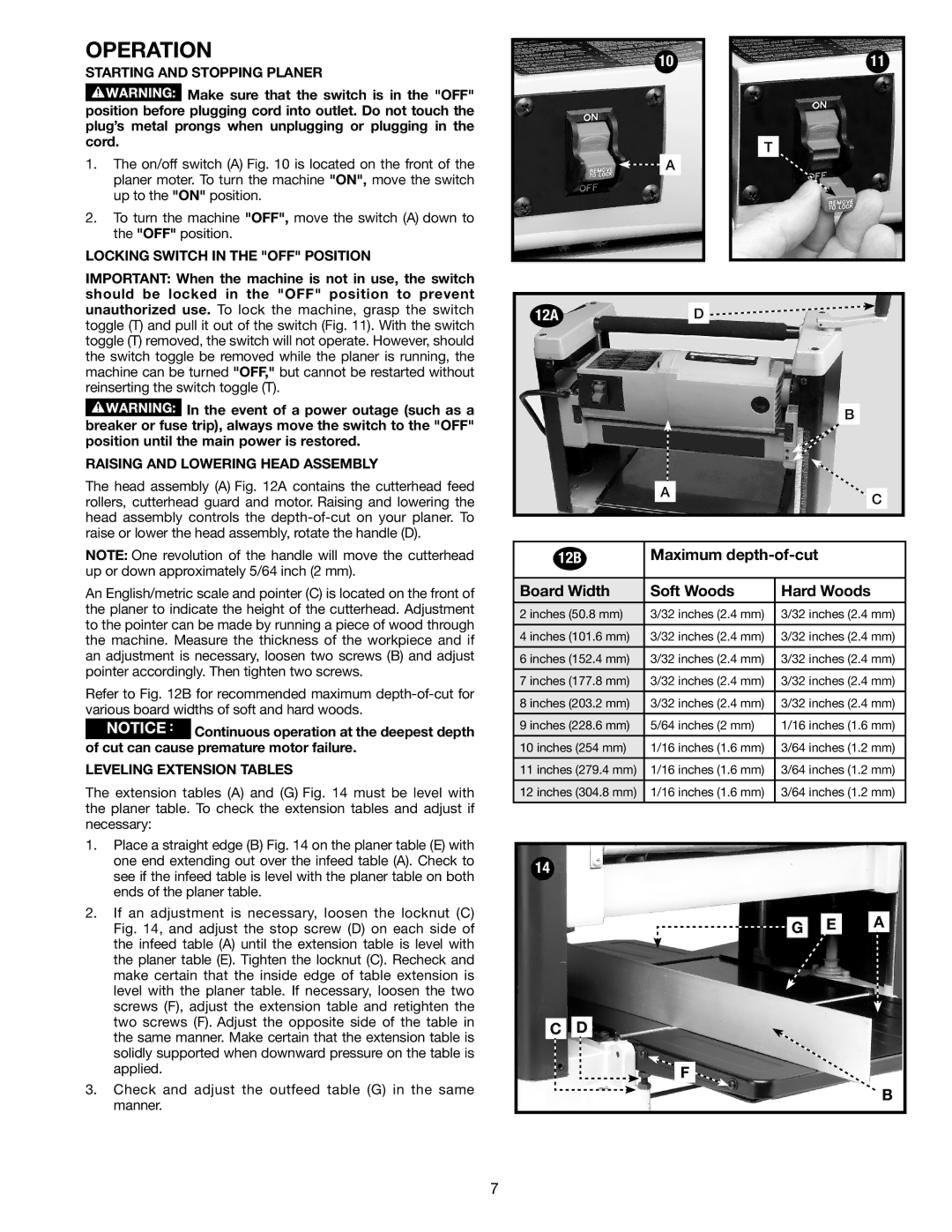
OPERATION
STARTING AND STOPPING planer
![]() Make sure that the switch is in the "OFF" position before plugging cord into outlet. Do not touch the plug’s metal prongs when unplugging or plugging in the cord.
Make sure that the switch is in the "OFF" position before plugging cord into outlet. Do not touch the plug’s metal prongs when unplugging or plugging in the cord.
1.The on/off switch (A) Fig. 10 is located on the front of the planer moter. To turn the machine "ON", move the switch up to the "ON" position.
2.To turn the machine "OFF", move the switch (A) down to the "OFF" position.
LOCKING SWITCH IN THE "OFF" POSITION
IMPORTANT: When the machine is not in use, the switch should be locked in the "OFF" position to prevent unauthorized use. To lock the machine, grasp the switch toggle (T) and pull it out of the switch (Fig. 11). With the switch toggle (T) removed, the switch will not operate. However, should the switch toggle be removed while the planer is running, the machine can be turned "OFF," but cannot be restarted without reinserting the switch toggle (T).
![]() In the event of a power outage (such as a breaker or fuse trip), always move the switch to the "OFF" position until the main power is restored.
In the event of a power outage (such as a breaker or fuse trip), always move the switch to the "OFF" position until the main power is restored.
raising and lowering head assembly
The head assembly (A) Fig. 12A contains the cutterhead feed rollers, cutterhead guard and motor. Raising and lowering the head assembly controls the
NOTE: One revolution of the handle will move the cutterhead up or down approximately 5/64 inch (2 mm).
An English/metric scale and pointer (C) is located on the front of the planer to indicate the height of the cutterhead. Adjustment to the pointer can be made by running a piece of wood through the machine. Measure the thickness of the workpiece and if an adjustment is necessary, loosen two screws (B) and adjust pointer accordingly. Then tighten two screws.
Refer to Fig. 12B for recommended maximum
NOTICE![]() Continuous operation at the deepest depth of cut can cause premature motor failure.
Continuous operation at the deepest depth of cut can cause premature motor failure.
leveling extension tables
The extension tables (A) and (G) Fig. 14 must be level with the planer table. To check the extension tables and adjust if necessary:
1.Place a straight edge (B) Fig. 14 on the planer table (E) with one end extending out over the infeed table (A). Check to see if the infeed table is level with the planer table on both ends of the planer table.
2.If an adjustment is necessary, loosen the locknut (C) Fig. 14, and adjust the stop screw (D) on each side of the infeed table (A) until the extension table is level with the planer table (E). Tighten the locknut (C). Recheck and make certain that the inside edge of table extension is level with the planer table. If necessary, loosen the two screws (F), adjust the extension table and retighten the two screws (F). Adjust the opposite side of the table in the same manner. Make certain that the extension table is solidly supported when downward pressure on the table is applied.
3.Check and adjust the outfeed table (G) in the same manner.
10 | 11 |
T
![]() A
A
12AD
B
A![]() C
C
12B | Maximum | |
|
|
|
Board Width | Soft Woods | Hard Woods |
|
|
|
2 inches (50.8 mm) | 3/32 inches (2.4 mm) | 3/32 inches (2.4 mm) |
|
|
|
4 inches (101.6 mm) | 3/32 inches (2.4 mm) | 3/32 inches (2.4 mm) |
|
|
|
6 inches (152.4 mm) | 3/32 inches (2.4 mm) | 3/32 inches (2.4 mm) |
|
|
|
7 inches (177.8 mm) | 3/32 inches (2.4 mm) | 3/32 inches (2.4 mm) |
|
|
|
8 inches (203.2 mm) | 3/32 inches (2.4 mm) | 3/32 inches (2.4 mm) |
|
|
|
9 inches (228.6 mm) | 5/64 inches (2 mm) | 1/16 inches (1.6 mm) |
|
|
|
10 inches (254 mm) | 1/16 inches (1.6 mm) | 3/64 inches (1.2 mm) |
|
|
|
11 inches (279.4 mm) | 1/16 inches (1.6 mm) | 3/64 inches (1.2 mm) |
|
|
|
12 inches (304.8 mm) | 1/16 inches (1.6 mm) | 3/64 inches (1.2 mm) |
|
|
|
14 |
|
|
|
| G | E | A |
C | D |
|
|
| F |
|
|
|
|
| B |
7
